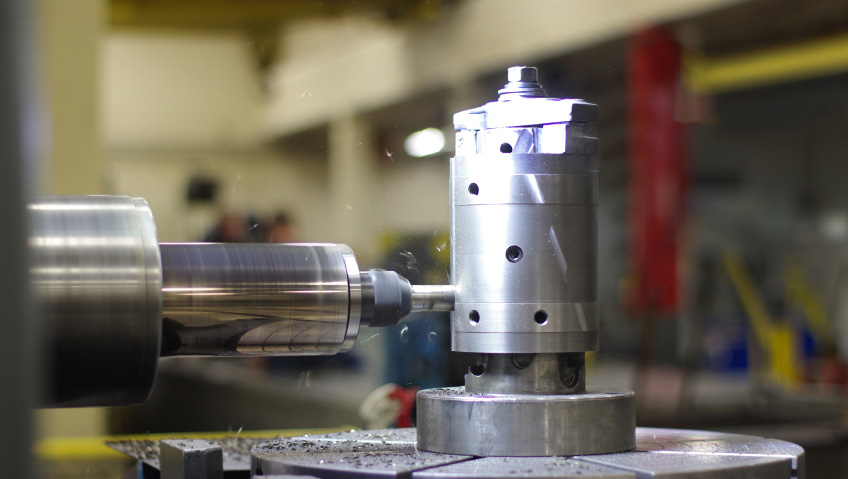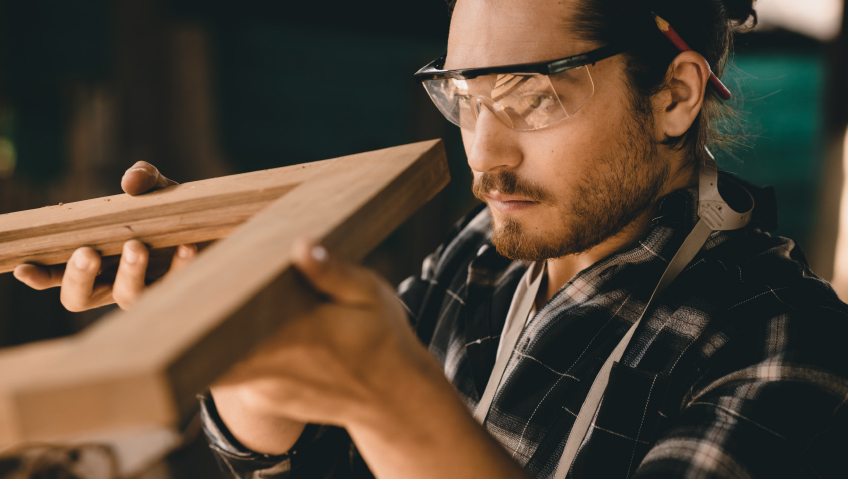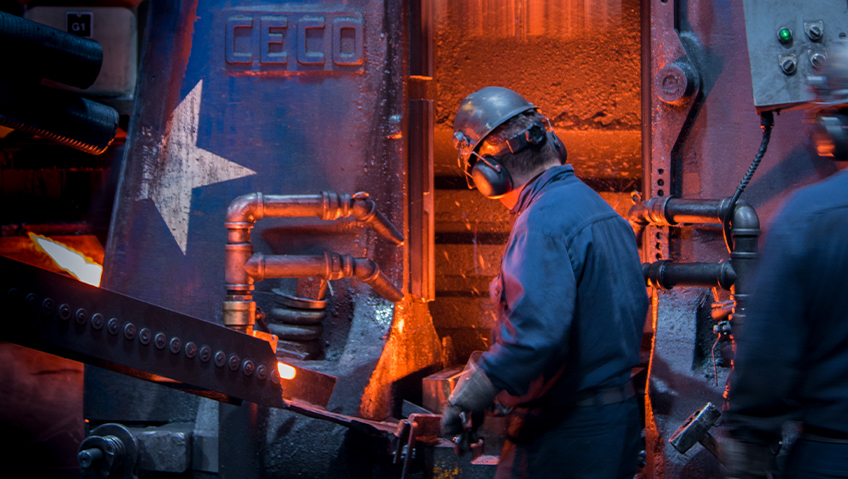Providing unique solutions for some of the most challenging manufacturing applications, Bourn & Koch is known for meeting customer needs through close interaction and enduring relationships. The machine tool systems from Bourn & Koch are simply the proud proof of its mastery of precision grinding and gear production equipment.
Providing repair parts, field service, retrofitting, and rebuilding, the company offers support for 28 American machine tool companies, stemming from its half-century of engineering experience. Bourn & Koch’s innovative solutions for today’s manufacturing market help to preserve and maintain the machines that shaped American industry and have never lost their usefulness and value.
Founded in 1975 in Rockford, Illinois by Larry Bourn and Loyd Koch—two “very mechanically minded” engineers at Sundstrand Machine Tool Company—the duo created their own business rebuilding and remanufacturing Sundstrand Machine Tools before purchasing the machine tool division of Barber Colman Company in 1985, another local business.
The company got into CNC gear manufacturing early on, explains Joe Goral, Sr., Vice President of Sales & Marketing. “At that point, we started getting more involved in custom machine tools made for very specific purposes, or customizing an existing machine to meet a very niche manufacturing challenge.”
That was followed by a line of medium-pitch gear hobbing machines and remanufacturing on some very large-gear machine tools for custom work, in addition to the building and rebuilding of machines. Many of these remanufacturing efforts drove new product developments. Fellows was acquired in 2002, further adding to the company’s gear machine tools. In 2004, Bourn & Koch purchased the assets of DeVlieg-Bullard Services Group, acquiring not only DeVlieg and Bullard but also OEM rights and intellectual property (IP) to notable machine tool manufacturers such as Blanchard, Mattison, Motch, Springfield and American Tool Works. Blanchard is still is one of the company’s primary brands, and to this day Bourn & Koch remanufactures, rebuilds, and builds them new.
“We have all of the IP for those companies—every print, drawing, file, manual, and schematic,” says Goral.
These acquisitions have influenced the development of the company’s products over the years into its core product line, including one of its latest products and flagship machines: MT3 (pronounced M-T cubed), which is primarily a precision vertical cylindrical grinder.
“Looking at Bourn & Koch today, and how we started designing and building new machines, the Barber Colman acquisition really influenced that,” says Goral. The acquisitions that followed had a similar influence on new products and also on the company’s remanufacturing and retrofitting talent. “We found one of our strong suits is putting new technology on those old machines that are still very sound mechanically but may need new controls. Of course, we can rebuild them and repair them as well.”
Along with those acquisitions, there is still that lively part of the business that deals in unique custom solutions, which is really who Bourn & Koch is at its core. And plenty of other newer technologies are also employed by the company in a pretty unique way, explains Goral.
“With MT3, we’re using the robot as a tool changer and a spindle changer for the machine, taking this newer technology and applying it in a new way,” he says. “There are other companies that do use a robot for maybe changing out a tool, but we’re using it to change out the entire spindle on the machine as well as the tool.” This approach allows the machine to use the right spindle, tailored for the machining operation, whether it be deep hole ID grinding with a long spindle and HSK-32 tool, or heavy-duty turning with a stout HSK-100 tool.
Bourn & Koch has also developed a unique end-of-arm tooling for the robot that allows it to grab both tools and spindles without changing over that end-of-arm tooling. This reduces the time it takes to change over to new tools or spindles.
On the workforce side, the company is using newer technologies to produce audio-visual and interactive work instructions. It’s about taking the institutional knowledge that has been built up in the business and distilling it to something accessible via a mobile kiosk on the floor.
“Whereas that knowledge may have existed only in the minds of two or three people who were doing the work, now somebody who recently joined the company and isn’t as versed in building machine tools has access to instructions and can get the job done,” says Goral. “Part of it is new technology on the solution side, and the other is embracing newer technologies on the workforce side and being able to train up the next generation in the work we do.”
The company is also strongly committed to maintaining exemplary customer care and relationships.
“A large focus of what we do is working hand-in-hand with companies to understand their needs and be able to meet them,” says Goral, “whether it’s with a solution that’s out of our portfolio or with something we design from the ground up.”
The companies that Bourn & Koch works with are referred to as “partners,” adds Goral, because when working on a project with clients, it’s a hand-in-hand approach.
“In most respects, it isn’t one-sided,” he says. “They’re coming to us when they have a need that few people can meet, that they’re having difficulty finding a solution for, and we’re willing to take on that task and solve it with them.”
Some of the companies Bourn & Koch partners with today go back to the 1980s, he adds. “We understand their needs and make sure we meet them. We write a very detailed scope of work for a project, which includes all technical and commercial requirements and covers stem-to-stern what we’re doing, making sure we’re doing what we say and saying what we do.” If anything changes throughout the process, there is a mutual agreement and documentation in place to ensure everyone is moving amicably toward the solution and delivering the value the customer expects.
“The biggest part of developing relationships and forging partnerships is that of companies coming back to us continually for a solution that meets or exceeds their needs.”
The business is also keenly customer-focused on the repair, parts, and service sides, he adds. Bourn & Koch services machines every day that may be anywhere from 40 to 50, 60, or even 100 years old that are out there still making parts.
“I’ve had a company wanting parts for a machine from 1914 that’s still making parts on their floor to this day,” says Goral. “These machines are still extremely useful because they were so well-built originally.”
It’s a very common occurrence, he adds, to receive a call from someone with a machine built in the 1950s or ’60s that is still running in their shop and turning out quality parts. “It’s difficult because now companies are basically designing obsolescence into their products,” Goral says. “But the iron in these machines is built to last forever; you could run one indefinitely as long as you kept updating the technology on it.”
This is precisely one of the biggest challenges customers have with operating this equipment. While the machines are still in excellent shape, some of the electronic components used at the time to build that particular machine are now obsolete. The challenge then is: retrofit it, or replace it? As often happens, companies find they can’t be without these machines, so replacement may be an enforced option.
For core brands like Blanchard and Fellows, however, Bourn & Koch typically aims to keep a machine available to tear down, rebuild, add CNC controls to, and then trade against the purchase so that downtime is minimal. It’s a unique solution the company can provide, while giving clients something familiar to them and at a better value, given that the cost of a remanufacturer-rebuilt machine is roughly 60 to 70 percent of new.
“They may not need every bell and whistle and every piece of technology that a new machine has, so remanufacturing a machine may fit the bill for them,” Goral says. “We try to understand that and make sure that when companies come to us looking for a solution to replacing a piece of equipment that we get a good grasp on what is really valuable to them and suggest the right solution based on that.”
Many of these machines have obsolete electrical components, so when one fails, it renders the machine inoperable in some cases. “We get to provide a solution to companies every day, whether it’s designing something from the ground up that meets their specific manufacturing challenges, or providing them a part for a machine that’s 70 years old and still producing—and we have it on the shelf!”
The creative component of bringing new life to old machines and delivering custom solutions this way is not only challenging, but a lot of fun, he adds. “Sometimes you get a problem and it’s like [working from] a blank sheet of paper, and you have to work hand-in-hand with somebody from the ground up,” Goral says.
“It’s not, ‘I need this, I saw this on your website or in your catalog, and this is what I’m buying from you.’ It’s, ‘I have this problem and I don’t know how we’re going to solve it. What do you think we can do?’” he explains. “Then we start talking and looking at drawings.”
This allows the company the opportunity to be on the ground floor with development while engaging in a bit of creativity as well. “People will bring us an obsolete machine with a very old technology that they rely on and ask us to design a new version, which is very cool. We’ve gotten involved in some very creative projects, and they’re fun to be a part of.”
As with many other industries at the moment, Bourn & Koch is finding it something of a challenge to replace the current wave of retirements. “It’s an industry that’s not well known as a place to make a living in,” Goral says. “That’s unfortunate because I have so much fun doing what I do. It’s a great industry to make a living in. You really get an opportunity to work with very cool technology.”
Bourn & Koch participates in Manufacturing Day for local colleges and high schools to help get the next generation involved while demonstrating the benefits of a manufacturing career, but it’s still an uphill battle. For instance, too many still don’t know there are paid apprenticeships in many fields.
“You can get an education while you’re on the job, and we offer a tuition reimbursement program, as do a lot of companies,” says Goral. “While you’re doing the job you can also get classes covered by the employer and find yourself in a very good role within a company where you can make a large impact.”
With these advantages, it’s surprising that the field isn’t more popular, but Bourn & Koch hopes to change things. “I think what we’re doing is cool and exciting,” Goral says. “There is so much variety and so many challenges that it makes every day a learning experience—something different, new, and exciting.”
He adds that it’s unfortunate that manufacturing doesn’t get more positive attention because the industry provides a great career once people “look behind the curtain” to see what’s happening. “There’s a whole lot going on that they’re not aware of, and it might pique their interest and make their day-to-day more exciting and a little more fun, too.”






